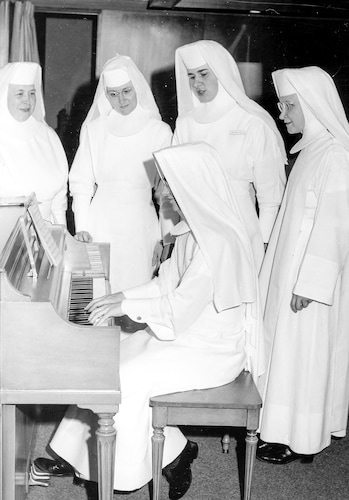In 1776, two Mexican Franciscans came north to explore territory that would become Utah. About 100 years later, Catholics would permanently settle on land largely populated by Native peoples and members of The Church of Jesus Christ of Latter-day Saints.
And when the United States celebrated its bicentennial in 1976, some 13,000 Catholics from across the Beehive State gathered in Salt Lake City’s Salt Palace for a celebratory Mass.
In the centuries in between, writes Colleen McDannell in her new book of historic photos, “Catholic Utah — Images of America,” members of Utah’s second largest religious tradition “had proudly established their ways of worshipping God in spaces throughout the state.”

(Sisters of the Order of St. Benedict) Taking a break from their medical responsibilities, sisters at St. Benedict's Hospital in Ogden enjoy a musical interlude in their convent.
They built churches and a cathedral, a network of parochial schools, hospitals, orphanages, convents and at least one monastery — much of the work done by “women religious,” namely nuns.
The project is part of a series by Arcadia Publishing, which specializes in regional history. The publisher reached out to McDannell, a prolific writer who had penned two previous books about the global faith (“Catholics in the Movies” and “The Spirit of Vatican II: A History of Catholic Reform in America”), and she relished the assignment.
(Roman Catholic Diocese of Salt Lake City archives) The Paulist Fathers, an American missionary order, coped with the vastness of the state by bringing "church" to dispersed Catholics, outfitting a trailer in 1938 as a "motor chapel."
“I wanted to explore how important the Catholic community was in building institutions,” says McDannell, the Sterling McMurrin professor of religious studies at the University of Utah.
It is both “a very communal religion and a very visual one,” the scholar says in an interview. “Consequently, local photographers gravitate to its rituals, spaces and people. There also was a Utah Catholic newspaper. So, I had many, many wonderful images to choose from.”
(Via the University of Utah) From left: Utah Gov. George Dern; Latter-day Saint apostle and future President George Albert Smith; and Monsignor Duane Hunt, who would become the Salt Lake City Diocese bishop in 1937, come together in September 1932 to unveil a monument honoring the Sisters of the Holy Cross for their contributions in education, health and social welfare.
Because McDannell sees religion “as a set of practices, rather than just beliefs,” it was easy for her to divide the treasure trove of images into chapters — sacred spaces, educating, healing, caring, leading and having fun.
Despite Catholicism’s male hierarchy, it is clear from the book that nuns played an outsized role helping to establish and maintain the faith’s charitable institutions among its ethnically and socially diverse populations.
“Women religious cared for orphans, the elderly, the disabled, and those Catholics outside of the parish structure,” McDannell writes in the book’s introduction. “...There never were enough priests to minister to the sparsely distributed community of Catholics…Laymen and laywomen, consequently, had to take on leadership roles in the parishes.”
(Roman Catholic Diocese of Salt Lake City archives) Parochial schools were essential to encouraging Catholic schoolchildren to devote their lives to the church. Here three children at St. Ann School in the early 1960s hold a doll wearing the habit of their teachers, the Sisters of Charity of the Incarnate Word.
The book ends in 1976 at a time when global Catholicism was evolving after Vatican II (1962-65) and American culture “was also rapidly changing,” she says. “Women, for instance, were entering the workforce and no longer had time for large amounts of religious volunteering.”
It allowed her “to focus on Catholic culture that flourished during the mid-20th century.”
There is “something wonderful about nostalgia,” McDannell notes. It can “be healing and uplifting.”
Today, Utah has more than 300,000 Catholics.
(Roman Catholic Diocese of Salt Lake City archives) At a 1966 spring celebration to honor the Virgin Mary, a student from St. Ann Parish wears an elaborate wedding dress — evoking both her First Communion and her future marriage.








